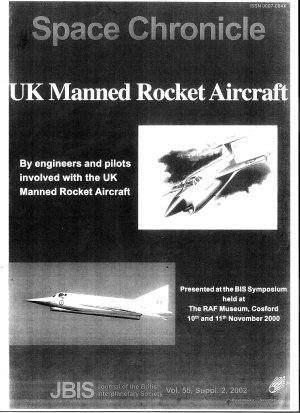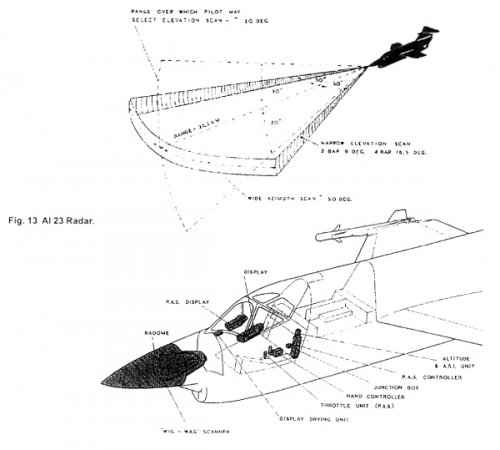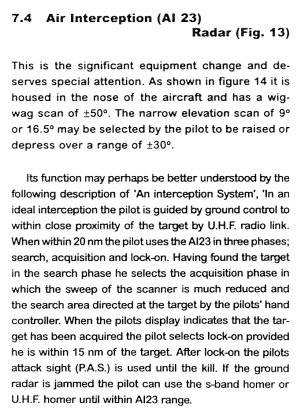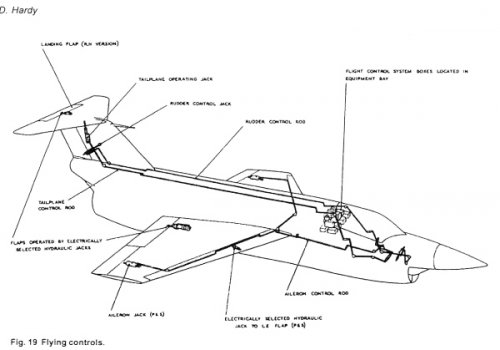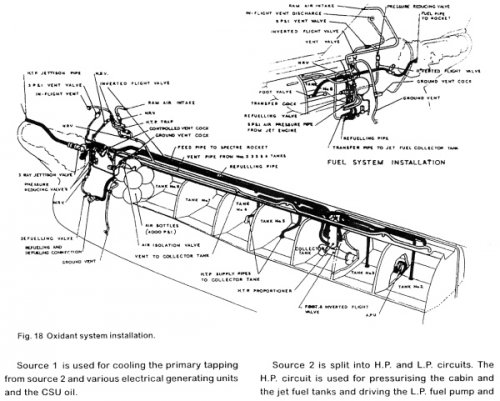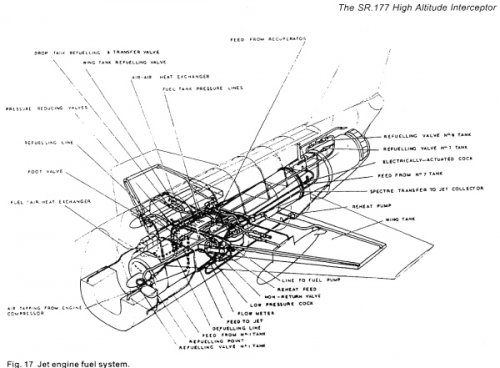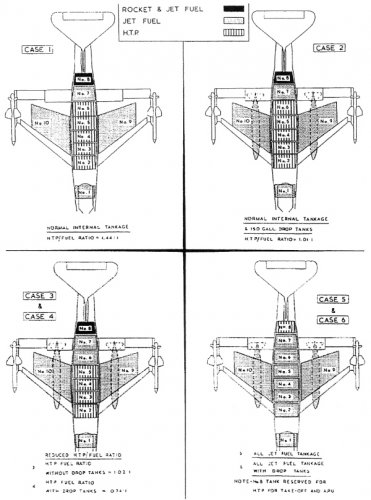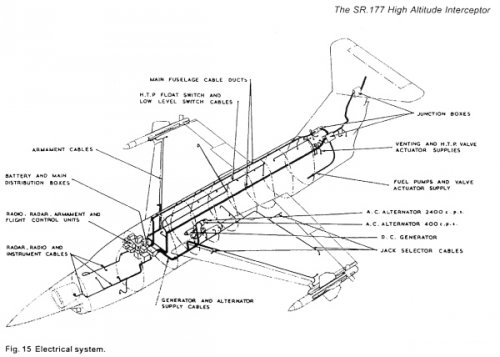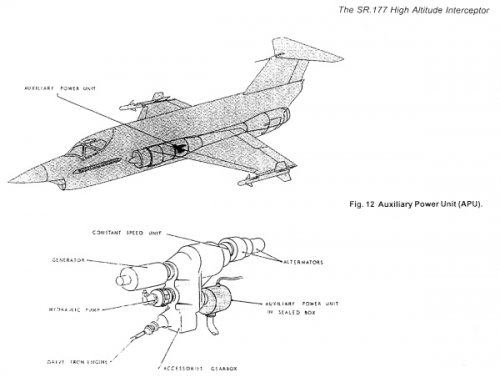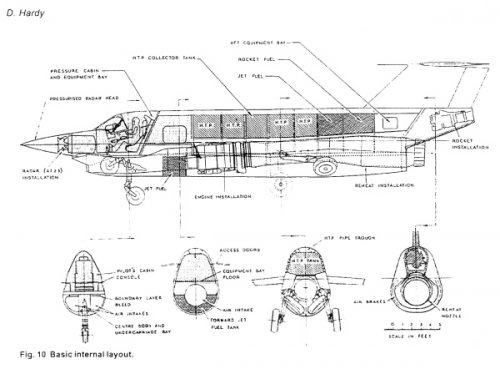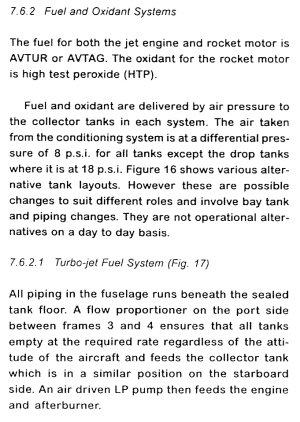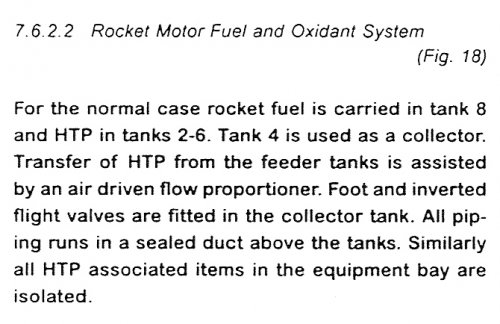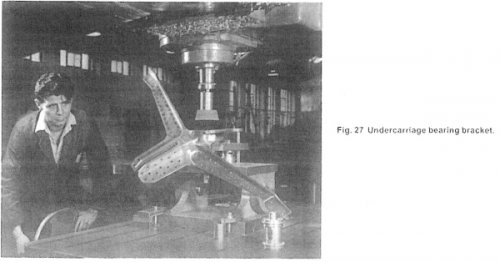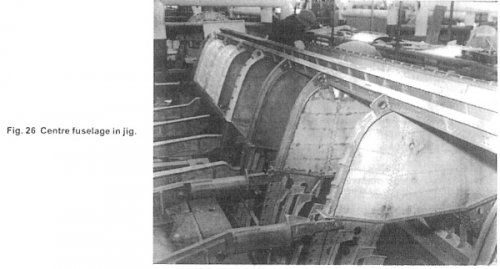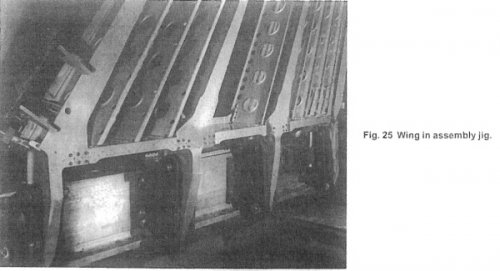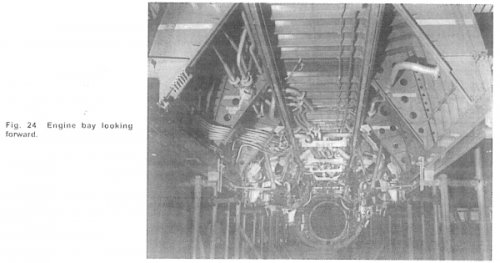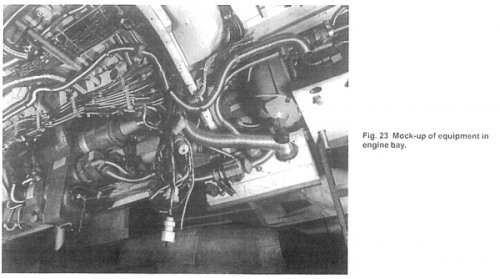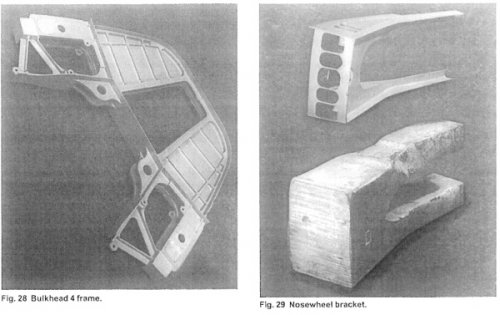You are using an out of date browser. It may not display this or other websites correctly.
You should upgrade or use an alternative browser.
You should upgrade or use an alternative browser.
Saunders Roe P.177 / SR.177
- Thread starter PMN1
- Start date
- Joined
- 1 January 2009
- Messages
- 138
- Reaction score
- 176
Brief summarisation of crash SR53 XD151, based on AIB Memo.
The accident occurred whilst the aircraft was taking off on a routine test flight. Take-off described as normal up to the usual unstick point (~23 secs from starting to roll) when rocket motor flame disappeared. Aircraft speed was 170 kts. About this time the pilot called “Panic stations”. Aircraft lost speed and nose-wheel dropped back on runway. Overshot end of runway despite application of wheel brakes and deployment of anti-spin parachute – which roman-candled. Ran through a line of lead-in light posts, striking one. Then ran down through security chain fence, demolishing eight of its reinforced concrete posts. Wing kerosene tanks probably ruptured at this point. Fence remained attached on left hand side and this pulled aircraft around, snapping off main undercarriage. As the aircraft slewed around it hit a larger lead-in light post with starboard wing. Thought that this impact ruptured fuselage kerosene and HTP tanks. Liberated kerosene flashed on contact with hot engine parts, disintegrating aircraft. Appears that HTP acted as smothering agent as the main ground fire was extinguished almost immediately. Pilot thrown from wreckage, still in ejection seat and killed.
Subsequent examination failed to reveal a cause. Pilot’s rearward folding front instrument panel had dropped behind control column. However, no firm evidence that that it had done so before explosion. Also thought that given pilot’s experience, he should have been able to cope with that occurrence. Seemed likely that pilot had cut Spectre rocket motor intentionally. Since Spectre bay fire extinguisher bottle had discharged one possibility was that shut down was in response to fire-warning light. Apparently no indication of pre-crash damage to engine. However an 0.125-inch hole of unexplained origin found in a stainless steel HTP pipe from first stage pump. Surmised that escaping HTP would have turned to steam and provided sufficient temperature rise to trigger fire detector.
The AIB concluded that "The primary cause of the accident remains obscure but the evidence suggests that an indication, or an occurrence in the cockpit, influenced the pilot to abandon the take-off at the most critical point, and the aircraft subsequently collided with massive obstructions"
The accident occurred whilst the aircraft was taking off on a routine test flight. Take-off described as normal up to the usual unstick point (~23 secs from starting to roll) when rocket motor flame disappeared. Aircraft speed was 170 kts. About this time the pilot called “Panic stations”. Aircraft lost speed and nose-wheel dropped back on runway. Overshot end of runway despite application of wheel brakes and deployment of anti-spin parachute – which roman-candled. Ran through a line of lead-in light posts, striking one. Then ran down through security chain fence, demolishing eight of its reinforced concrete posts. Wing kerosene tanks probably ruptured at this point. Fence remained attached on left hand side and this pulled aircraft around, snapping off main undercarriage. As the aircraft slewed around it hit a larger lead-in light post with starboard wing. Thought that this impact ruptured fuselage kerosene and HTP tanks. Liberated kerosene flashed on contact with hot engine parts, disintegrating aircraft. Appears that HTP acted as smothering agent as the main ground fire was extinguished almost immediately. Pilot thrown from wreckage, still in ejection seat and killed.
Subsequent examination failed to reveal a cause. Pilot’s rearward folding front instrument panel had dropped behind control column. However, no firm evidence that that it had done so before explosion. Also thought that given pilot’s experience, he should have been able to cope with that occurrence. Seemed likely that pilot had cut Spectre rocket motor intentionally. Since Spectre bay fire extinguisher bottle had discharged one possibility was that shut down was in response to fire-warning light. Apparently no indication of pre-crash damage to engine. However an 0.125-inch hole of unexplained origin found in a stainless steel HTP pipe from first stage pump. Surmised that escaping HTP would have turned to steam and provided sufficient temperature rise to trigger fire detector.
The AIB concluded that "The primary cause of the accident remains obscure but the evidence suggests that an indication, or an occurrence in the cockpit, influenced the pilot to abandon the take-off at the most critical point, and the aircraft subsequently collided with massive obstructions"
- Joined
- 26 January 2011
- Messages
- 2,226
- Reaction score
- 645
zen said:High Test Peroxide would'nt explode or even burn that much without contact to the catalyst. Its far safer than the sort of reactants the Germans where using in WWII.
As Orion has indicated, it more volatile than you appear to believe. That volatility is one of the major reasons why most Western navies abandoned its use in heavy torpedos. The Swedes and the Russians are the only ones I'm aware that still use it and IIRC after the Kursk disaster, the Russians announced it was going to be phased out (explosion of one of the torpedos on that Submarine are believe to have caused its loss). The Bluesteel motors and fuels required special handling procedures and storage facilities, limiting the bases on which the Vulcans and Victors carrying them could operate from.
- Joined
- 15 July 2007
- Messages
- 4,889
- Reaction score
- 4,553
As Orion has indicated, it more volatile than you appear to believe.
Nope, I'm reasonably aware of its dangers, but its a hell of a lot safer than LOx.
It was used in a Torpedo and caused an explosion, due to leakage onto Brass fittings in a RN submarine back in the 50's. It seems the Russians where using it, and had a similar incident in the Kursk.
I did'nt know the Swedes where using it though.
At the time, the options where LOx or HTP for the oxident, and of the two the latter is much safer and easier to handle and store.
Fascenating and thankyou yellowaster.However an 0.125-inch hole of unexplained origin found in a stainless steel HTP pipe from first stage pump. Surmised that escaping HTP would have turned to steam and provided sufficient temperature rise to trigger fire detector.
It does raise the question of how that hole was produced, if it was through corrosion you'd think they'd have concluded such back then.
- Joined
- 1 January 2009
- Messages
- 138
- Reaction score
- 176
zen,
regarding XD151 and the hole in stainless steel HTP pipe (20 SWG, 0.25-inch OD). Pipe was analysed by AID labs, who concluded it was electrical in origin, caused by arcing with a PVC-covered copper cable. The AIB report then goes on to state that the only cables in Spectre bay were instrumentation, load not exceeding 2.5A, and fuzed to 10A. Thus difficult to see how these cables could have produced the damage. Also concluded that there was no possibility of hole occurring post-crash. So cause of the hole seems to be a mystery. It seems odd that more isn't made of this in the conclusion of the report.
yellowaster
regarding XD151 and the hole in stainless steel HTP pipe (20 SWG, 0.25-inch OD). Pipe was analysed by AID labs, who concluded it was electrical in origin, caused by arcing with a PVC-covered copper cable. The AIB report then goes on to state that the only cables in Spectre bay were instrumentation, load not exceeding 2.5A, and fuzed to 10A. Thus difficult to see how these cables could have produced the damage. Also concluded that there was no possibility of hole occurring post-crash. So cause of the hole seems to be a mystery. It seems odd that more isn't made of this in the conclusion of the report.
yellowaster
- Joined
- 15 July 2007
- Messages
- 4,889
- Reaction score
- 4,553
wonderful stuff here!
Explaining much indeed.
But its clear that the radar is the letdown IMO, as 20nm is very low. A bigger dish is needed, and that would push it back into the nose, not sure it could be done or where some of the equipment would go instead.
Really could do with a F8 style arragement there.
Explaining much indeed.
But its clear that the radar is the letdown IMO, as 20nm is very low. A bigger dish is needed, and that would push it back into the nose, not sure it could be done or where some of the equipment would go instead.
Really could do with a F8 style arragement there.
- Joined
- 27 December 2005
- Messages
- 17,752
- Reaction score
- 26,449
20 nm is not low at all given the age and size of the radar. It is perfectly adequate for interception given ground radar assistance. The AI 23 was developed quite a bit further on the Lightning, and had some excellent ECCM features for example.
- Joined
- 27 December 2005
- Messages
- 17,752
- Reaction score
- 26,449
Anyone interested in this article can buy the whole issue on UK Rocket Fighters online
http://www.bis-spaceflight.com/sitesia.aspx/page/183/id/470/l/en-gb
£10 for download.
http://www.bis-spaceflight.com/sitesia.aspx/page/183/id/470/l/en-gb
£10 for download.
- Joined
- 15 July 2007
- Messages
- 4,889
- Reaction score
- 4,553
The US concluded sternchase interception was'nt worth the candle in 1959 and even the UK realised head on engagement not only extended the range at which an interception could take place (key figure if you want to stop a stand-off bomber), but was the more desirable method by 1956.
P.177 was to fly out to the incomming target, see it, and turn hard onto its tail before engaging.
Red Top would extend the angles out to try for a side shot, but head on with the weapon is asking a lot of it despite the sales blurb. It needs a SARH seeker for the job and that means fitting an illuminator to AI.23.
20nm is not long from detection to passing the target when considering the combined closing speed.
My suspicion is that this is why Friedman mentions AI.20, since if it could be upped on the detection range it already had a narrow high power beam for illumination (orriginaly for beam riding Fireflash) that could guide a SARH AAM. But as is, the working sets only made 10nm for detection of a bomber.
But really this aircraft needs a 30 inch dish and detection ranges to match that, with a SARH AAM or ARH AAM.
This is why most of the Fighter requirements talk of a 30 inch dish as their prefered option, though for the F155T they where looking at 40 inches.
P.177 was to fly out to the incomming target, see it, and turn hard onto its tail before engaging.
Red Top would extend the angles out to try for a side shot, but head on with the weapon is asking a lot of it despite the sales blurb. It needs a SARH seeker for the job and that means fitting an illuminator to AI.23.
20nm is not long from detection to passing the target when considering the combined closing speed.
My suspicion is that this is why Friedman mentions AI.20, since if it could be upped on the detection range it already had a narrow high power beam for illumination (orriginaly for beam riding Fireflash) that could guide a SARH AAM. But as is, the working sets only made 10nm for detection of a bomber.
But really this aircraft needs a 30 inch dish and detection ranges to match that, with a SARH AAM or ARH AAM.
This is why most of the Fighter requirements talk of a 30 inch dish as their prefered option, though for the F155T they where looking at 40 inches.
- Joined
- 15 July 2007
- Messages
- 4,889
- Reaction score
- 4,553
Red Steer had a 24 inch dish, while the earlier set used in the Vulcan was still the 18inch dish of Green Willow. If memory serves as I don't have my calculator with me, its about double the dish area, so if nothing else changes an increase of 25%.
But the power had increased as well so range could be a bit higher.
But the power had increased as well so range could be a bit higher.
- Joined
- 1 January 2009
- Messages
- 138
- Reaction score
- 176
Regarding Red Steer. There were two marks. Red Steer Mk.1 was essentially AI.20 with cover extended from 60-degrees to 90-degrees (which reduced the range but provided better warning). This was replaced by Red Steer Mk.2 (new scanner and display, other improvements as well) which was designed to give a missile-approach warning capability i.e. could pickup seperation of AAM from an attacking fighter.
- Joined
- 22 April 2012
- Messages
- 2,258
- Reaction score
- 2,309
Sorry to bring this thread back from the dead but I am rather curious regarding this aircraft and its engine issues. Tony Butler states that the aircraft in its production form would have had a 10,000lb thrust Gyron Junior with 14,000lb at re-heat (roughly equating to what the Bristol 188 got; may have even been the same DGJ engine) . What speed would the after burner, without the rocket, have been able to drive the SR.177? Supersonic? Were further Gryson Junior variants proposed?
Secondly, does anyone know the details of the rolls Royce engines proposed? Some sources state the RB.153 was put forward, however the highest thrust I have seen for this engine is 8000lb with re-heat, considerably below the Gyron Junior talked about by Gunston. Any further info on this?
Secondly, does anyone know the details of the rolls Royce engines proposed? Some sources state the RB.153 was put forward, however the highest thrust I have seen for this engine is 8000lb with re-heat, considerably below the Gyron Junior talked about by Gunston. Any further info on this?
- Joined
- 27 December 2005
- Messages
- 17,752
- Reaction score
- 26,449
Well, I'm not sure SR.177 would be that supersonic generally without some redesign with area ruling.
- Joined
- 15 July 2007
- Messages
- 4,889
- Reaction score
- 4,553
I have the complete section dealing with the P.177 from the book Saro Aircraft from....(I always forget the date).
The Attack version for the Luftwaffe seems to use the RB.133 Avon, which if its the same output as the stretched SeaVixen strike proposal is about 13,200lb (figure is rough from memory).
I thought in this thread is a Saro diagram showing the mission for DLI, with some figures for dry, reheated and reheated with rocket peformance?
The Attack version for the Luftwaffe seems to use the RB.133 Avon, which if its the same output as the stretched SeaVixen strike proposal is about 13,200lb (figure is rough from memory).
I thought in this thread is a Saro diagram showing the mission for DLI, with some figures for dry, reheated and reheated with rocket peformance?
- Joined
- 15 July 2007
- Messages
- 4,889
- Reaction score
- 4,553
Not sure about linking in pictures on this forum from its own threads, does this work?
If their figures are on the button, this machine does mach 0.9 at 37,800ft without reheat. Strongly suggestive reheat is going to drive it through the sound barrier and well into the supersonic regime.
Notice how the rocket motor is purely for high altitude acceleration and climb. Prior that part of the mission is turbojet only, but with quite a bit of reheat to get to altitude.
- Joined
- 22 April 2012
- Messages
- 2,258
- Reaction score
- 2,309
RB.133 makes considerably more sense than the RB.153! As I understand it this was developed as a high altitude engine for the Canberra PR.9 and came out heavier than the RA.24? I would assume that this would require considerably more space than the Gyron Junior, did this proposal dispose of the Rocket altogether? I will check BSP Jet Fighters when I get home for the RB.133 thrust figures if they are there. The RB.133 would make the RB.106 a viable option if its development had been continued. Equally there was the RB.126 proposed for the EE P.8 with 13,400lb dry.
I assume the new wing you alluded to earlier is the 4% one proposed for the strike variant? What was the thickness of the original navy SR.177 wing?
I assume the new wing you alluded to earlier is the 4% one proposed for the strike variant? What was the thickness of the original navy SR.177 wing?
- Joined
- 22 April 2012
- Messages
- 2,258
- Reaction score
- 2,309
I have just checked BSP Jet Bombers and the stated thrust of the RB.133 is 13,880lbs. Damn near what the final Gyron PS.50 was expected to produce with re-heat. Do we know if the RB.133 for the German SR.177 had reheat?
According to some sources the redesign with the RB.133 was completed so their must be an image of the design somewhere and details regarding the design changes. Bill Gunston seems to lose interest in the design just prior to the RR engine selection. Does Derek Wood mention an afterburner / re-heat for the RB.133?
According to some sources the redesign with the RB.133 was completed so their must be an image of the design somewhere and details regarding the design changes. Bill Gunston seems to lose interest in the design just prior to the RR engine selection. Does Derek Wood mention an afterburner / re-heat for the RB.133?
Last edited:
- Joined
- 15 July 2007
- Messages
- 4,889
- Reaction score
- 4,553
Its not clear, but this alternative engine is supposedly aimed at the medium to low level use on the aircraft. Which seems odd considering the engines orrigins.
Its seems plausable they stuck with reheat, but this might have been limited in diameter, possibly like on the Lightning. The only diagrams I have for the RB.106 reheat chambers are in BSP1, and seem to imply a 44 inch diameter or greater, whereas the Gyron Junior's chamber is about 36 inches as depicted in a cutaway of the P.177 from the Saro book.
In theory it might have been possible to increase reheat chamber diameter to something like 44 or 45 inches, accepting the chambers outer walls are part of the fusilage exterior, but the effect on the undercarridge could be prohibitive.
Similarly it might have been possible to increase dish diameter, with consequences for the nose length and possibly the inlet design.
On the wing, its stated how surprising it was that the RAF and RN machines were so close to each other, so there maybe no difference in the wings external shape at all. The only differences is stated as strengthening for catapult spools, arresting gear and extra fuel.
So the wing is 6%.
Chin inlet is stated as variable and of the double shock type.
Its seems plausable they stuck with reheat, but this might have been limited in diameter, possibly like on the Lightning. The only diagrams I have for the RB.106 reheat chambers are in BSP1, and seem to imply a 44 inch diameter or greater, whereas the Gyron Junior's chamber is about 36 inches as depicted in a cutaway of the P.177 from the Saro book.
In theory it might have been possible to increase reheat chamber diameter to something like 44 or 45 inches, accepting the chambers outer walls are part of the fusilage exterior, but the effect on the undercarridge could be prohibitive.
Similarly it might have been possible to increase dish diameter, with consequences for the nose length and possibly the inlet design.
On the wing, its stated how surprising it was that the RAF and RN machines were so close to each other, so there maybe no difference in the wings external shape at all. The only differences is stated as strengthening for catapult spools, arresting gear and extra fuel.
So the wing is 6%.
Chin inlet is stated as variable and of the double shock type.
- Joined
- 29 September 2006
- Messages
- 1,794
- Reaction score
- 1,360
RB.133 rings a bell - it may have been referenced in Derek Wood's 'Project Cancelled'. My copy is far, far away - can anyone take a look?
- Joined
- 27 December 2005
- Messages
- 17,752
- Reaction score
- 26,449
I don't have Donald Wood's book. Derek Wood's book says RB.133 
- Joined
- 29 September 2006
- Messages
- 1,794
- Reaction score
- 1,360
overscan said:I don't have Donald Wood's book. Derek Wood's book says RB.133
Corrected, my copy must have been from Scotland
alertken said:Wood, P.69: Sept.1957: "at very short notice Saro re-designed 177 around RB133 instead of PS.50 (ak:which had reheat), and with a thinner wing".
Hi Alertken ,
“……and with a thinner wing"; this is true, the designer of the wing said, told me that they were designing a new wing at about the time of cancellation. It was suggested from another source that an all steel wing be introduced at some time. Something was said about the engine but I can not recall now what was said. The MoS wanted an all steel aircraft but Maurice Brennan refused to go along that route.
Just a thought but has any one details of the SR177 variant that was to be piggybacked and launched at altitude from the back of a Vulcan?
- Joined
- 29 September 2006
- Messages
- 1,794
- Reaction score
- 1,360
Spark said:alertken said:Wood, P.69: Sept.1957: "at very short notice Saro re-designed 177 around RB133 instead of PS.50 (ak:which had reheat), and with a thinner wing".
Hi Alertken ,
“……and with a thinner wing"; this is true, the designer of the wing said, told me that they were designing a new wing at about the time of cancellation. It was suggested from another source that an all steel wing be introduced at some time. Something was said about the engine but I can not recall now what was said. The MoS wanted an all steel aircraft but Maurice Brennan refused to go along that route.
Just a thought but has any one details of the SR177 variant that was to be piggybacked and launched at altitude from the back of a Vulcan?
There is a page on a SARO proposal paper which included air launching the SR.53 from a Valiant at the UK Space Page - is that what you're thinking of? http://www.spaceuk.org/sr53/sr53%20research.htm
EDIT: Diagram of the Valiant mounted SR.53 a third of the way down this page http://www.spaceuk.org/sr53/sr53%20pics.htm
- Joined
- 15 July 2007
- Messages
- 4,889
- Reaction score
- 4,553
I think we don't know to be honest and it needs some digging to find out if the information still exists that is.
Even if it has reheat, the question then is what kind of reheat, full wack or some sort of limited type.
A smaller diameter chamber is going to limit the available thrust, something I think like this existed for the SAAB Lansen, as they could'nt fit the full Avon reheat chamber into the fusilage.
Even if it has reheat, the question then is what kind of reheat, full wack or some sort of limited type.
A smaller diameter chamber is going to limit the available thrust, something I think like this existed for the SAAB Lansen, as they could'nt fit the full Avon reheat chamber into the fusilage.
starviking said:Spark said:alertken said:Wood, P.69: Sept.1957: "at very short notice Saro re-designed 177 around RB133 instead of PS.50 (ak:which had reheat), and with a thinner wing".
Hi Alertken ,
“……and with a thinner wing"; this is true, the designer of the wing said, told me that they were designing a new wing at about the time of cancellation. It was suggested from another source that an all steel wing be introduced at some time. Something was said about the engine but I can not recall now what was said. The MoS wanted an all steel aircraft but Maurice Brennan refused to go along that route.
Just a thought but has any one details of the SR177 variant that was to be piggybacked and launched at altitude from the back of a Vulcan?
There is a page on a SARO proposal paper which included air launching the SR.53 from a Valiant at the UK Space Page - is that what you're thinking of? http://www.spaceuk.org/sr53/sr53%20research.htm
EDIT: Diagram of the Valiant mounted SR.53 a third of the way down this page http://www.spaceuk.org/sr53/sr53%20pics.htm
Hi Starviking,
Definitely the SR177; the proposal was to re-engine with similar engine to the Blue Steel stand of bomb. This may have been early but am not certain. The first in this series of proposed research aircraft to support the RAF/Commonwealth manned space programme was a variant of the Avro 720 piggybacked by the early Vulcan, the illustration depicted a straight leading edge for the Vulcan Delta.
- Joined
- 22 April 2012
- Messages
- 2,258
- Reaction score
- 2,309
Zen,
The re-heat issue certainly remains an open one with a range of variables. However the redesign seems to be regarded as having been completed so somewhere there must be a definitive answer on this issue???
The re-heat issue certainly remains an open one with a range of variables. However the redesign seems to be regarded as having been completed so somewhere there must be a definitive answer on this issue???
- Joined
- 17 October 2006
- Messages
- 2,393
- Reaction score
- 1,197
I believe Gunston refers to the idea of a steel wing and high Mach number, either in Early Supersonic Fighters or an Aeroplane Monthly article.
Both Gunston and Wood were huge SR177 fans. It was an interesting concept in that it gave you some of the characteristics of a 1960s-type afterburning turbofan - reasonable subsonic cruise efficiency and a a huge thrust boost (but very high SFC) for high Mach. Plus the fact that it was a rocket opened up the high-altitude envelope.
But it was always hard to see HTP being used routinely in service, after reading the accounts of HTP mishaps in Ziegler's Rocket Fighter.
Both Gunston and Wood were huge SR177 fans. It was an interesting concept in that it gave you some of the characteristics of a 1960s-type afterburning turbofan - reasonable subsonic cruise efficiency and a a huge thrust boost (but very high SFC) for high Mach. Plus the fact that it was a rocket opened up the high-altitude envelope.
But it was always hard to see HTP being used routinely in service, after reading the accounts of HTP mishaps in Ziegler's Rocket Fighter.
- Joined
- 26 January 2011
- Messages
- 2,226
- Reaction score
- 645
The RN had had some very nasty accidents with HTP when they'd tried to use it as a torpedo fuel. I really wonder they'd been willing to repeat the experience onboard carriers? However, the RAF managed to use it in the Blue Steel.
- Joined
- 22 April 2012
- Messages
- 2,258
- Reaction score
- 2,309
The RN's HTP torpedo experience was shown at the time to have been a product of trying to do things on the cheap, reusing the Mk 8 torpedo casing as the basis for the Fancy is what proved disasterous and this was well known. Interestingly the Swedes proved able to use HTP torpedos without incident based on British developments.
At one point during the design process for HMS Eagle's reconstruction she had a pure aluminum tank designed into the area previously occupied by the forward 4.5 inch magazines so they obviously were not that worried about it. However, it is also worth noting that by the late 50s the SR.177 was the RN's only hope for a missile and radar armed supersonic fighter so to an extent they did not have much choice.
According to Friedman, with just the Gyron Junior and the rocket tanks filled with jet fuel the SR.177 would have been capable of Mach 0.97 at sea level with an endurance of 2 hours. This certainly suggests that with something like the RB.106 Thames this could have been a potent little aircraft. Interestingly Friedman also states that the radar was to be the AI.20?
At one point during the design process for HMS Eagle's reconstruction she had a pure aluminum tank designed into the area previously occupied by the forward 4.5 inch magazines so they obviously were not that worried about it. However, it is also worth noting that by the late 50s the SR.177 was the RN's only hope for a missile and radar armed supersonic fighter so to an extent they did not have much choice.
According to Friedman, with just the Gyron Junior and the rocket tanks filled with jet fuel the SR.177 would have been capable of Mach 0.97 at sea level with an endurance of 2 hours. This certainly suggests that with something like the RB.106 Thames this could have been a potent little aircraft. Interestingly Friedman also states that the radar was to be the AI.20?
Last edited:
- Joined
- 15 July 2007
- Messages
- 4,889
- Reaction score
- 4,553
This certainly suggests that with something like the thames this could have been a potent little aircraft. Interestingly Friedman also states that the radar was to be the AI.20?
Would seem so, I'll have to go back to my photocopies and check the reheat chamber diameter as thats the key issue for the Thames.
The AI.20 is a bit of a poser from Friedman, and I do wonder why he writes that. What schematics of the cockpit I've seen suggest a hand controller like in the Lightning and other indications of the use of AI.23 albeit with a 18inch dish.
Which takes me to a some strange musings on AI.20, since this is the only set the UK has with a strong beam function aimed at guidance of a beamriding missile, but in theory there is nothing precluding its use for semi-active homing guidance instead, bar the issue of keeping the beam on the target.
We know from Friedman and the Admiralty records, that they see collision course interception as the more capable method, compared to stern chase it allows a interception at greater distance from the carrier. But at the time, Red Dean is dead, and Red Hebe is sometime in the future, so they only have the Firestreak IR homer available, with all that means for stern chase interceptions only.
- Joined
- 26 January 2011
- Messages
- 2,226
- Reaction score
- 645
sealordlawrence said:Rickshaw,
The RN's HTP torpedo experience was shown at the time to have been a product of trying to do things on the cheap, reusing the Mk 8 torpedo casing as the basis for the Fancy is what proved disasterous and this was well known. Interestingly the Swedes proved able to use HTP torpedos without incident based on the british developments.
You miss my point. I was referring to perceptions about the dangers of using HTP, particularly at sea, rather than necessarily the realities. As I also pointed out, the RAF managed to utilise it with Blue Steel, although their experience was that it required _very_ careful handling. Something the Luftwaffe during WWII also found. The Swedes OTOH utilised a pre-packaged HTP fuel source for their Torpedos. They do not attempt to fuel or service them on the short-ranged missions they undertake. That is a very different experience to trying to fuel and maintain an aircraft at sea. So there are indications in both directions. Personally, I wouldn't want to touch it with a bargepole.
- Joined
- 1 January 2009
- Messages
- 138
- Reaction score
- 176
zen said:This certainly suggests that with something like the thames this could have been a potent little aircraft. Interestingly Friedman also states that the radar was to be the AI.20?
Would seem so, I'll have to go back to my photocopies and check the reheat chamber diameter as thats the key issue for the Thames.
The AI.20 is a bit of a poser from Friedman, and I do wonder why he writes that. What schematics of the cockpit I've seen suggest a hand controller like in the Lightning and other indications of the use of AI.23 albeit with a 18inch dish.
Which takes me to a some strange musings on AI.20, since this is the only set the UK has with a strong beam function aimed at guidance of a beamriding missile, but in theory there is nothing precluding its use for semi-active homing guidance instead, bar the issue of keeping the beam on the target.
We know from Friedman and the Admiralty records, that they see collision course interception as the more capable method, compared to stern chase it allows a interception at greater distance from the carrier. But at the time, Red Dean is dead, and Red Hebe is sometime in the future, so they only have the Firestreak IR homer available, with all that means for stern chase interceptions only.
Zen,
I think you may be mistaken regarding AI.20 having a beam-guidance function. It had a simple spiral-scan search mode and a con-scan radar-ranging attack mode. Designed for a stern attack with guns or Firestreak.
yellowaster
Similar threads
-
Saunders-Roe P.187 : F.155T contender
- Started by blackkite
- Replies: 15
-
-
-
-
Hawker Hunter Precursor and Follow-on Projects
- Started by hesham
- Replies: 67

